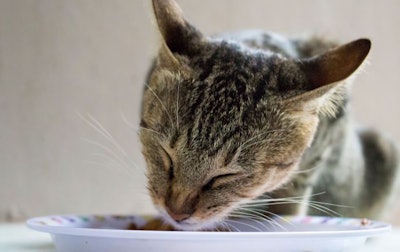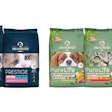
Advances in pet food palatability technologies, such as dry palatants, drying methods and fat application, help manufacturers optimize pets’ enjoyment while addressing both nutrition and pet owners’ desires to please their pets.
Pet food palatability has taken on new importance as dog and cat owners increasingly view pets as family. Pet parents want to see dogs and cats obviously enjoying their food, according to Chloé Champion, marketing and communication director for Diana Pet Food, yet people want the pet foods to be healthy too.
“Owners consider meal times a key moment to strengthen the emotional bond with their pets,” Champion told Petfood Industry. “Therefore, food performance no longer simply focuses on pets' preferences, but takes into account a human dimension: the pet owners’ perception of their pet’s enjoyment.
“Pet food manufacturers have a strategic opportunity to develop products which not only meet nutritional requirements and satisfy hunger, but also stimulate an emotional response in pets that is clearly perceptible to the owner,” she said.
The secret to achieving that type of pet food is a holistic approach, backed up by science, Champion said. From the start, when a pet food company sets out to improve palatability, their strategy should assess raw material and ingredient quality.
Once the characteristics of the starting product are known, accurate rating of a pet food’s performance in terms of key palatability aspects, particularly smell for dogs and taste for cats, should provide usable feedback, she said. That information enables manufacturers to tweak processes until they achieve the best expression of the formula.
Palatant options: dry versus wet
One of those processes that can be adjusted is the use of palatants. Traditionally, pet food manufacturers have used wet palatants, but dry palatants have been increasing in popularity, Gordon Stirling of AFB International, told Petfood Industry.
“Dry flavors are more concentrated and can deliver a higher level of performance with the same application rate,” he said.
The choice between wet and dry palatants can meet very different manufacturer’s needs, said Champion.
“From an industrial perspective dry palatants have easier logistics, storage and cleaning conditions, yet their application proves to be more challenging (than wet) when used in topical coating,” she said.
Performance often drives the decision between wet and dry palatants, she said.
“Olfaction is a key palatability driver for dogs,” she said. “Wet palatants and their volatile aromatic compounds are essential to satisfy dogs’ sensitive noses.”
However, despite observably increasing dogs’ dietary delight, high levels of those odors can destroy pet owners’ ability to enjoy their dogs’ mealtimes.
“While dogs may be attracted to pungent odors, owners may be unwilling to tolerate that stink in their homes, said Kadri Koppel, PhD, assistant professor at Kansas State University, during her keynote address at Petfood Innovation Workshop 2017.
Dry palatants ideal for cat food
For cats, palatability involves more factors, and felines can be finicky, said Champion. Somesthesia, or bodily sensations, and taste most heavily influence cat food palatability. Dry palatants effectively trigger both of these senses.
Dry palatants are “a must” for cat food manufacturers wishing to provide top cat palatability performance, Champion said.
“Ultimately, the choice between dry and wet palatant will be a compromise between industrial setup, cost constraints and expected performance level,” she said.
Vaccuum coating offers advantages
Along with decisions between wet versus dry palatants, formulators have an increasing range of options for influencing pet food palatability as new technologies are developed and refined. One such pet food technology is the use of vacuum coating to apply palatants.
A vacuum coater is a batch mixer that sucks the air out of a kibble chamber before palatants and fat are applied. After application, the vacuum is slowly relieved, which draws the fat and palatant coatings more deeply into the kibble than under normal atmospheric conditions.
“It allows higher amounts of fat to be added to the kibble, which has a role in palatability and nutrition,” said Stirling.
“For the palatant application to be successful, vacuum coating must be part of a sequence process,” he said. “For instance, if you are using a dry palatant, the vacuum must be controlled so that fat remains on the surface to hold the dry coating.”
Drying technology designed to improve palatability
Another innovation in palatability involves alterations to the palatant drying process. In 2015, Diana Pet Food, LIS, Triballat‐Noyal and Clextral combined investments to set up an extrusion porosification technology (EPT) pilot plant in Europe.
EPT involves a palatant drying innovation developed and patented by Clextral, Champion said. This process produces novel porous powders with improved functional properties, such as rehydration and flowability. Also, these powders manufactured by EPT process should enhance the aromatic profile to boost pets’ satisfaction with their sensory experience of eating.
Weight-control pet foods and palatability
These emerging palatability technologies both aim to tantalize pets’ senses and thereby increase their attraction to the food. Yet for many animals, especially in the United States, overindulgence in that tempting pet food contributes to obesity and related health problems. To address these issues, palatability can play a key role.
“Weight management diets are sometimes less palatable to the pet, and this observation is noticeable to the pet parent,” said Stirling. “Palatants provide the enticement for the pet, which in turn makes it acceptable to the pet parent to continue feeding the weight management diet.”
Another enticement to pets is the fat coating on kibble often applied along with palatants. Those fats are nearly 100 percent digestible in both conventional and weight-control dog food formulations, according to research published in June by the Journal of Animal Science.
“The correct use of palatants and fat coating will assure diet acceptability of weight-control products,” the study’s lead author Fábio Ritter Marx, an animal nutrition consultant in Brazil, told Petfood Industry. “However, the amount of fat coated should be as low as possible to provide the correct amount of essential fatty acids to meet the requirements without causing significant dietary energy-density increase.”
Palatants in weight-control pet foods
Reducing the energy density of a pet’s diet is one main strategy for developing a weight loss plan for a pet, said Champion. Another is to use satiating foods that decrease and delay the onset of an animal’s hunger. Palatability is crucial to both strategies.
“In both cases, it is mandatory to develop foods with a high attractivity, meaning no food refusals,” she said. “If these conditions are not met, pets will develop begging and scavenging behaviors, and owners will be tempted to provide more food than needed.”
To fight the problem of overfeeding, pet owners need education on behavioral cues that a pet wants no more food, as opposed to out-right refusing to eat, she noted. This education could come from veterinarians, pet food companies or other knowledgeable sources.
Pet food palatability and consumers’ emotions
Ultimately, observation made of pet owners during these educational sessions could shed light on how people assess their pets’ emotional states, particularly while eating, Champion said.
“Owners have become more attentive to their animal’s emotions, because they want to ensure their pet’s enjoyment and well-being and share positive and unique interactions with them,” she said. “This has created fresh consumer expectations for pet food.”
Pet owners around the world seem likely to increasingly look for strong signs of their pets’ enjoyment of food. Because of this, pet food palatability provides a “groundbreaking opportunity” for dog and cat food brands to differentiate themselves in the market, she said.
More on pets’ preferences
















